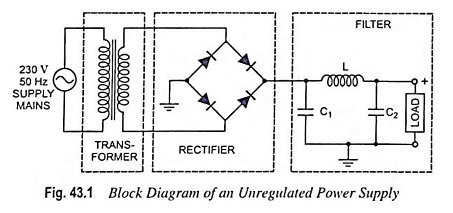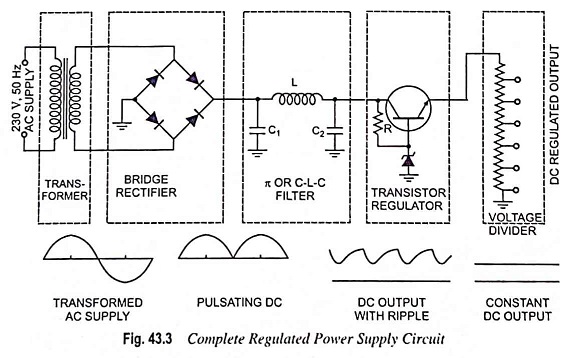Regulated and Unregulated Power Supply:
Almost all electronic devices used in electronic circuits need a dc source of power to operate. The source of dc power is used to establish the dc operating points (Q-points) for the passive and active electronic devices incorporated in the system. The dc power supply is typically connected to each and every stage in an electronic system. It means that the single requirement common to all phases of electronics is the need for a supply of dc power. For portable low-power systems batteries may be used, but their operating period is limited. Thus, for long time operation frequent recharging or replacement of batteries become much costlier and complicated. More frequently, however, electronic equipment is energized by a power supply, derived from the standard industrial or domestic ac supply by transformation, rectification, and filtering. The combination of a transformer, a rectifier and a filter constitutes an ordinary dc power supply, also called an unregulated power supply.
The block diagram of an ordinary power supply is depicted in Fig. 43.1. Usually, a small dc voltage, in the range of 2-24 volts is required for the operation of different electronic circuits, while in India, single-phase ac supply is available at 230 V. So a small step-down transformer is used at the beginning which reduces the voltage level according to the needs. Next block is a rectifier which converts the sinusoidal ac voltage into pulsating dc. In the last there is a filter block which reduces the ripples (ac components) from the rectifier output voltage. The filter is a device which passes dc component to the load and blocks ac components of the rectifier output.
For many applications in electronics, unregulated power supply is not good enough because of the following reasons.
1. Poor Regulation: The output voltage does not remain constant as the load varies. The internal resistance of an ordinary power supply is relatively large (more than 30 Ω. So output voltage is significantly affected by the magnitude of current drawn from the supply. The voltage drop in the internal resistance of the supply increases directly with an increase in load current.
2. Variations in the AC Supply Mains: The permissible variation in the ac supply mains voltage as per Indian Electricity Rules is 6% of its rated value. But in India, the variations in ac mains voltage is much more than this (sometimes it may vary from 180 V to 260 V). The dc output voltage being proportional to the input ac voltage, therefore, varies largely.
3. Variations in Temperature: The dc output voltage varies with temperature, particularly if semiconductor devices are employed.
These variations in dc output voltage may cause inaccurate or erratic operation or even malfunctioning of many electronic circuits. For instance, in oscillators the frequency will shift, in transmitters output will get distorted, and in amplifiers the operating point will shift causing bias instability.
Some feedback arrangement (acting as a voltage regulator) is employed in conjunction with an unregulated power supply to overcome the above mentioned three shortcomings and also to reduce the ripple voltage. Such a system is called a regulated power supply.
In many applications, it is important to protect the power supply output against inadvertant short circuits that might destroy either the circuit under test or operation of the supply itself. Thus, current limiting circuits are often incorporated into the regulator design.
Power supplies are becoming steadily more sophisticated in terms of performance objectives and application strategies. A commercial power supply is typically a complex system that makes use of ICs to reduce ripple, improve regulation, and widen control options. Programmable power supplies are also available to allow remote operation that is useful in many settings.
A regulated power supply is an electronic circuit that is designed to provide a constant dc voltage of predetermined value across load terminals irrespective of ac mains fluctuations or load variations.
A regulated power supply essentially consists of an ordinary power supply and a voltage regulating device, as illustrated in Fig. 43.2. The output from an ordinary power supply is fed to the voltage regulating device that provides the final output. The output voltage remains constant irrespective of variations in the ac input voltage or variations in output (or load) current.
Figure 43.3 shows the complete circuit of a regulated power supply with a transistor series regulator as a regulating device. The ac voltage, typically 230 Vrms is connected to a transformer which transforms that ac voltage to the level for the desired dc output. A bridge rectifier then provides a fullwave rectified voltage that is initially filtered by a π-(or C-L-C) filter to produce a dc voltage. The resulting dc voltage usually has some ripple or ac voltage variation. A regulating circuit uses this dc input to provide a dc voltage that not only has much less ripple voltage but also remains constant even if the input dc voltage varies somewhat or the load connected to the output dc voltage changes. The regulated dc supply is available across a voltage divider.
Often more than one dc voltage is required for the operation of electronic circuits. A single power supply can provide as many voltages as are required by using a voltage (or potential) divider, as illustrated in the figure. As illustrated in Fig. 43.3, a potential divider is a single tapped resistor connected across the output terminals of the supply. The tapped resistor may consist of two or three resistors connected in series across the supply. In fact, bleeder resistor may also be employed as a potential divider.


